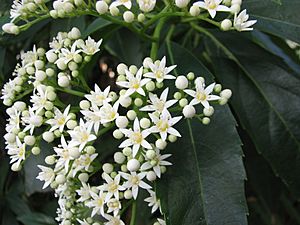Cuttsia facts for kids
Quick facts for kids Cuttsia |
|
|---|---|
 |
|
| Cuttsia viburnea | |
| Scientific classification | |
| Genus: |
Cuttsia
|
| Species: |
viburnea
|
Cuttsia viburnea is a special kind of shrub or small tree. It grows only in eastern Australia. This plant has leaves with tiny teeth and pretty white flowers that grow in bunches. People sometimes call it the silver-leaved cuttsia. It can also be called native elderberry, honey bush, or native hydrangea. But be careful! These names are also used for other Australian plants. Cuttsia viburnea is the only plant in its group, called the Cuttsia genus.
Contents
What it Looks Like
The silver-leaved cuttsia can grow as a shrub or a small tree. It can reach up to 15 meters (about 50 feet) tall. Its younger branches are soft and green at first. They have small, raised spots called lenticels, which help the plant breathe.
The young shoots and flower clusters have tiny hairs that lie flat. The leaves grow one after another along the stems. Each leaf has a stem (called a petiole) that is about 1.5 to 4.5 cm long.
The leaf blades are smooth and soft. They are bright green and shiny on top, and a lighter color underneath. They are oval-shaped, usually 8–20 cm long and 2–6.5 cm wide. The edges of the leaves have small, even teeth, and each tooth has a tiny gland. The tip of the leaf is pointed.
Flowers and Fruit
The flowers grow in large clusters called panicles, which are 8–18 cm long. The flowers are shaped like a star and have a nice honey scent. Each flower has five small green parts called sepals, which are less than 1 mm long. There are also five white petals, shaped like long, upside-down teardrops, about 3–4 mm long.
Inside the flower, there are five thin white parts called filaments. These alternate with the petals and have small yellow tips called anthers. The anthers release cream-colored pollen. The flowers bloom from October to December.
After the flowers, the plant produces a small, round or oval fruit. This fruit is a green to light brown capsule, about 3–4 mm long. Each part of the capsule opens separately. Inside, there are tiny, oval-shaped seeds.
Plant Family and History
The Cuttsia plant and its species were first officially described in 1865. This was done by a botanist named Ferdinand von Mueller. He wrote about it in his book Fragmenta Phytographiae Australiae.
Modern Plant Groups
Cuttsia is closely related to two other plant groups: Abrophyllum and Carpodetus. These three were once grouped together in a family called Carpodetaceae.
Scientists have used genetic analysis to study plant relationships. This research showed that these plants are also closely related to Roussea. Roussea is a plant found only on the island of Mauritius. Because of these findings, all these plants are now part of a larger plant family called Rousseaceae.
Where it Grows
The silver-leaved cuttsia grows along the eastern coast of Australia. You can find it between Noosa Heads, Queensland and Newcastle, New South Wales. There are also a few separate places where it grows in the mountains of Queensland.
How it Lives
The silver-leaved cuttsia lives in subtropical and warm-temperate rainforests. It prefers places where it can get more sunlight. This includes the edges of forests, areas where new plants are growing, and along streams.
The flowers produce a sweet liquid called nectar. Many different insects visit the flowers to feed on this nectar. These insects help the plant by carrying its pollen. It is also said that adult jewel beetles, like the Calodema regalis, feed on Cuttsia plants.
See also
 In Spanish: Cuttsia para niños
In Spanish: Cuttsia para niños

